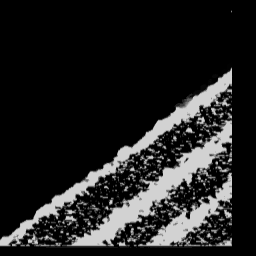 released intermittently and the particles segregate as they flow
downslope. The reason for this is that, as the material shears the
small particles are simply more likely to fall through the gaps that
open up beneath them than the large ones. A bi-disperse mixture of
grains rapidly forms a two-layer structure, with the large particles
overlying the smaller ones. When the front of the avalanche comes to
rest on a run-out plane a shock
wave is generated, which propagates rapidly upslope freezing the
segregation pattern into the deposited material. The animated gif
image shows the passage of two avalanches that each leave a pair of
stripes in the deposit with the large white particles overlying the
small dark ones.
released intermittently and the particles segregate as they flow
downslope. The reason for this is that, as the material shears the
small particles are simply more likely to fall through the gaps that
open up beneath them than the large ones. A bi-disperse mixture of
grains rapidly forms a two-layer structure, with the large particles
overlying the smaller ones. When the front of the avalanche comes to
rest on a run-out plane a shock
wave is generated, which propagates rapidly upslope freezing the
segregation pattern into the deposited material. The animated gif
image shows the passage of two avalanches that each leave a pair of
stripes in the deposit with the large white particles overlying the
small dark ones.
![[Stratification patterns in a rotating drum]](Fig-b3-09a.jpg)
![[Continuous segregation in a rotating drum]](Fig-b3-09b.jpg)
It is also possible to generate stratification patterns by slow rotation of a disk filled with a bi-disperse granular material. At low revolution rates stripes form tangent to the free surface and are then rotated and buried to produce a Catherine wheel pattern (left). At faster rotation rates a continuous flow regime is entered in which the intermittency and shock waves disappear. The free surface is instead quasi-steady and there is a continuous particle size distribution outside the central core with the larger particles concentrated near the edge of the disk (right).
Publications
Gray, J.M.N.T. & Hutter, K. (1997). Pattern formation in granular avalanches. Contin. Mech. & Thermodyn. 9(6), 341-345. (pdf)Gray, J.M.N.T. & Hutter, K. (1998). Physik granularer Lawinen. Physikalische Blatter 54(1), 37-43.
Gray, J.M.N.T., Tai, Y.C. & Hutter K. (2000). Shock waves and particle size segregation in shallow granular flows. IUTAM Symposium on segregation in granular materials (Eds. A.D. Rosato & D.L. Blackmore), Kluwer Academic Publishers. 269-276.
Back to the departmental homepage.
Please send any feedback, comments or suggestions to ngray@maths.man.ac.uk.
Page last modified: December 22, 2000